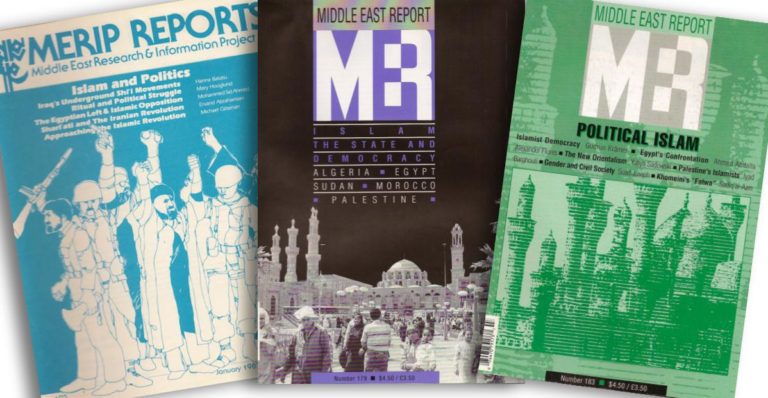
MERIP Reports and Middle East Report covers from 1982, 1992 and 1993.
While MERIP did not initially appreciate or anticipate the powerful Islamist forces that would consolidate power after the 1979 revolution in Iran, MERIP writers would soon begin to explore the political dimensions of religion. In 1982 it offered back-to-back special issues. As its editors explain, in “Islam and Politics” they sought to explore “the material conditions underlying concrete manifestations of Islam as a political force.” The issue includes studies by Hanna Batatu about Iraq’s underground Shi’i movements and the significance of one of their leaders, Muhammad Baqir al-Sadr. The following issue on “The Politics of Religion” offered two reports from Egypt. Eric Rouleau situated Anwar Sadat’s assassination within the context of the late president’s manipulation of religion to prop up his regime while Saad Eddin Ibrahim offered a socioeconomic portrait of Egypt’s religious militants. Other essays offered, as the editors explained, “a range of perspectives on how the left should comprehend and respond to political Islam.”
Across MERIP’s coverage there is an insistence on the plural nature of Islamism. MERIP authors reject the common notion that Islamism is a coherent and unitary political ideology with a set of inflexible ideological principles and positions, standardized across time and space, intent on regional domination. Prominent examples of this alternative approach are Michael Gilsenan’s 1988 review of Gilles Kepel and Emmanuel Sivan’s work and Curtis Ryan’s sharp analysis of the Jordanian Muslim Brotherhood in 2015. The essays collected in a 1997 volume, Political Islam: Essays from Middle East Report edited by Joel Beinin and Joe Stork, demonstrate how MERIP has been offering readers a complex view of Islamism since the 1980s. MERIP articles show why national and sub-national differences matter and how ideologues employing the same religious sources can come to opposite conclusions about political behavior. MERIP authors examine conflicts among different movements in the same country and across countries that are intense and irreconcilable and look at how diverse interactions with the state and wider society inform and shape both ideology and behavior. While unusual in the 1980s and 1990s, these are now uncontroversial approaches for those seeking to understand political Islam. Following in this tradition, Rikke Hostrup Haugbølle and I offered an examination of the Tunisian al-Nahda party, led by Rachid Ghannouchi in the wake of the 2011 revolution, that emphasized the importance of analyzing how ideas and practices of Islamism evolve within society and, crucially, how they might filter up to Islamist political movements.
MERIP’s roots in materialist political economy and a focus on leftist movements might suggest a bias against movements that came to replace the left as the dominant form of political opposition against authoritarian regimes. MERIP authors have, however, engaged with Islamist movements’ own ideas, declarations and stances and reported on them non-judgmentally. This approach helped plant the seeds for students of political Islam to pay attention to what Islamists said, how and in what context they said it, and how others encountered their claims. Paying attention to the context of Islamist speech as well as to its variety led MERIP to engage debates that anticipated real changes on the ground, such as one explored by Gudrun Kramer in 1993 in his “Islamist Notions of Democracy.” Among other examples are Hanna Batatu’s 1982 essay on the Syrian Muslim Brothers that suggests the philosophical connections between aspects of their Islamism and classical liberalism.
The distinctiveness of MERIP and its analyses of political Islam is exemplified by Charles Hirschkind’s 1997 article “What is Political Islam?” that challenges superficial perceptions and explanations and laid the groundwork for future examinations of such phenomenon without preconceived notions. Key to this distinctiveness is the depth of empirical work emerging from MERIP articles. Put simply, across the range of studies MERIP has offered, there is not a singular MERIP approach to political Islam, but there is a MERIP approach to doing research and informing readers: an approach based on intellectual honesty and theoretical pluralism.
[Francesco Cavatorta is professor of political science at Laval University in Quebec, Canada and co-editor of a 2020 special issue of the journal Politics & Religion on Islamism, Islamist parties and economic policymaking in the neo-liberal age.]
